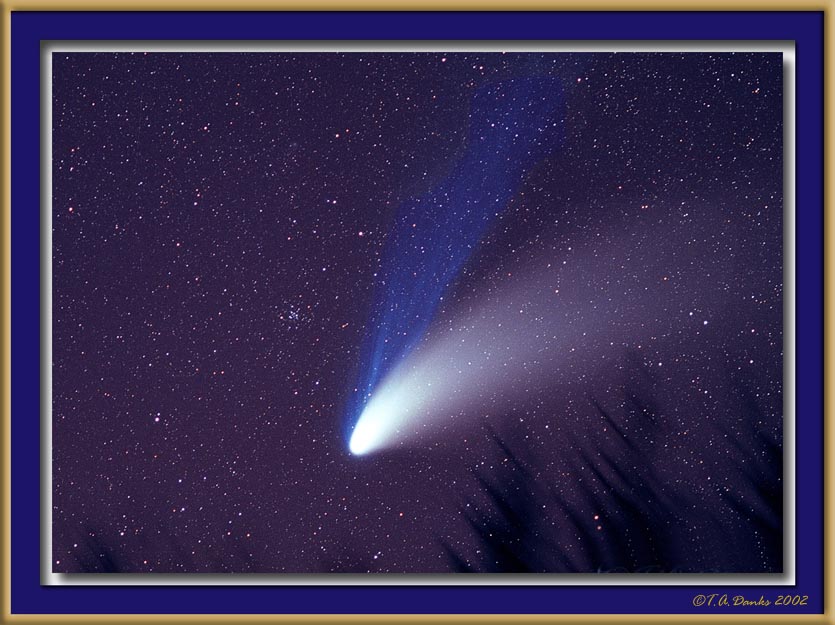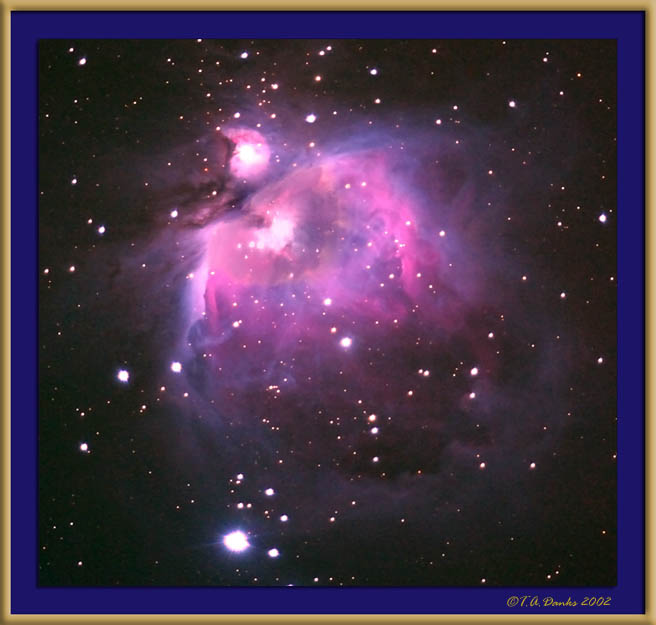
Very Old Images
This is all old stuff and does not match the quality of imaging easily achieved today. It is of historic interest only showing how far amateur imaging has come, and I leave it here for that reason.
Comet Hale-Bopp

Taken April 5th, 1997 from Middle River, Nova Scotia, Canada using a 135mm lens at f/2.8. Film was Fuji Super G+, ISO 800 exposed for 5 minutes. The camera was mounted "piggyback" on a guiding telescope which was clock driven to compensate for the earth's rotation. The dark slash marks in the lower right hand corner are fir trees in the foreground blurred by the telescope's motion as it tracked the comet.
Hale-Bopp was an interesting comet that clearly showed two distinct tails. The broad, fan-tailed whitish one is a dust tail shining by the reflected light of incident sunlight. The more interesting, tightly confined bluish tail is composed of gas. It shines under the influence of solar short wavelength ultraviolet radiation, much as the gas in a fluorescent light fixture shines.
On this date the comet was approximately 130 million miles from earth.
The Great Spiral Galaxy in Andromeda

This galaxy is a nearby neighbour of our own Milky Way and resembles it in many ways. The Milky Way would look very similar to this if we could somehow view it from a comparable distance. The Andromeda Galaxy is 2,500,000 light years from earth, meaning this picture shows it as it was two and half million year ago! It is unlikely it has changed much in the interim for, in the life of a galaxy, such a span is but a short time. There are about 200 billion stars in this galaxy.
This image is a composite of four frames exposed through a Canon EF300mm f 2.8L IS lens for a total duration of 17 minutes at f2.8. The camera body was a Canon D60 digital and the frames were exposed at the ISO 800 setting. The date was Sept. 7, 2002.
The Orion Nebula - M42

For those unfamiliar with the night sky, the Orion nebula is a cloud of hydrogen gas largely ionised by the young, very hot stars embedded within it. These stars were born from the gas cloud and, for this reason, nebulae such as these are often called "stellar nurseries." This nebula is approximately 1500 light years from Earth. It is visible to the unaided eye as a faint, fuzzy patch below the three prominant stars of Orion's belt and is quite unmistakable, if unspectacular, in binoculars.
This image is a composite of four 5 minute exposures exposed through a Canon EF600 f 4.0L IS lens. The camera body was a Canon D60 digital and the frames were exposed at the ISO 800 setting. The date was Nov. 4, 2002.
Use "Back" button or Return to TAD's Photography Home Page